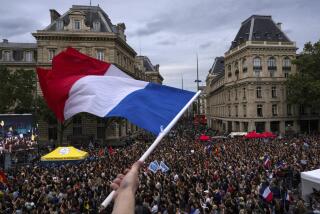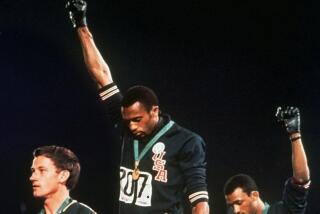PARIS TO DAKAR : 6 Deaths Produce a Furor
- Share via
PARIS — As always, the images on French television that came back from the Paris-to-Dakar rally this year were spectacular: Powerful cars zooming through African sandstorms in the eerie blue twilight, the wheels of motorcycles setting off geysers of golden sand as they crossed the Sahara, trucks struggling like helpless white monsters through great sand dunes.
But the rally ended in the third week of January without the usual glory and pride and sense of excruciating accomplishment. Partly because of six deaths this year, a morose mood shrouded the rally and provoked a great deal of soul-searching afterward about its future. In its 10 years, the Paris-Dakar has never been the subject of so much bitter criticism.
The catalogue of problems was long this year. Accidents killed three competitors and left two paralyzed. More than 50 others were injured. A racing car knocked down and killed a 10-year-old African girl trying to cross the road in Mali. A camera car rammed into bystanders in a Mauritanian village, killing a mother and child. These accidents raised the death toll in the 10 years of the Paris-Dakar rally to 26.
To add to the gloom, an extremely difficult route eliminated most of the 349 cars, 206 motorcycles and 115 trucks early in the rally. Amateurs were among the first to abandon the course, making it more clear than ever that the Paris-Dakar was now dominated by teams sponsored and maintained by car, cycle and truck manufacturers. Some observers believed that these professional teams helped force a pace that was too difficult and dangerous for others to follow.
A ludicrous note was added in Bamako in the last week when someone stole the Peugeot 205 of the rally leader, Finnish driver Ari Vatanen. The car was found abandoned hours later. Vatanen was eliminated from the rally under international regulations that require a driver to show up no later than a half hour beyond his scheduled start.
Most observers had expected Vatanen to win the rally, and angry words passed between the organizers of the Paris-Dakar, who wanted to excuse the lateness of Vatanen, and Jean-Marie Balestre, president of the International Federation of Automobile Sports, who insisted that rules were rules.
The rally was engulfed at the end by so much controversy and disappointment and speculation about the future that the winners were barely mentioned in newspaper headlines after they reached Dakar on Jan. 22. Juha Kankkunen of Finland led the cars in a Peugeot 205, Eddy Orioli of Italy led the motorcyclists in a Honda, and Karel Loprais of Czechoslovakia led the trucks in a Tatra.
The Paris-Dakar was first organized by a young French publicist, Thierry Sabine, who dreamed of a rally that would send cars, trucks and motorcycles along primitive roads and across the desert in one of the world’s least-developed regions. He hoped that the Paris-Dakar would become the most grueling car race on earth.
Although the route differs every year, it follows the same general pattern. In 1988, the rally started in Versailles outside Paris on the morning of Jan. 1, moved south through France to the Mediterranean coast, went by sea from Sete west of Marseilles to Algiers, and then on through Algeria, Niger, Mali, Mauritania, and Senegal to Dakar. The finishers had covered 8,000 miles in three weeks of driving.
The rally lends itself to flights of imagery. Paris-Match, the weekly French photo magazine, calls it “the cruel and magnificent Paris-Dakar.” A headline in the Paris newspaper Le Monde described this year’s rally as “a pleasure of hell.” The beauty and rigors of the desert, with temperatures rising to more than 100 degrees during the sun-baked days and dropping to freezing under deep blue skies at night, with lovely dunes clogging the way of bone-tired drivers, has attracted an international following, including celebrity participants like Prince Albert of Monaco.
The rally, in fact, first achieved a kind of worldwide notoriety in 1982, when another celebrity, British Prime Minister Margaret Thatcher’s son, Mark, lost his way in the desert of Algeria, and the Algerian government ordered troops to find him and his car, which they eventually did.
In 1986, Sabine, only 37 years old, died when a helicopter, surveying the rally, crashed in the desert. Four others, including a popular French singer, Daniel Balavoine, died in the crash. Unlike the accidents of this year, these deaths did not threaten the future of the rally. The deaths, in fact, fed an emotional, almost defiant need to keep the rally going in the memory of Sabine.
A number of detractors banded together a few years ago in a group called Pa’Dak. The name is a kind of pun, for it is a contraction that could stand for Paris-Dakar or for a French idiom that means “We don’t agree.” The founders of Pa’Dak included the late writer Simone de Beauvoir and Rene Dumont, the renowned expert on French agriculture.
Pa’Dak denounced the use of Africa as a playground. “While it has proved impossible to help Africa develop,” the group said in a statement, “ways have nonetheless been found, 25 years after decolonization, to send hundreds of vehicles careening across the continent for the benefit of car manufacturers and to the great delight of those who enjoy watching jet-setters sweating it out.”
The Catholic Church joined the critics in full force this year. Bishop Jacques Gaillot of Evreux called the rally “an insult to the dignity of man.” The Vatican newspaper Osservatore Romano, in the midst of the rally, denounced its heavy commercialization. Although the rally gets support from entry fees, a government subsidy and the sale of television rights, it is heavily dependent on sponsors who advertise on the cars and uniforms of the drivers.
After the church criticism, Balestre, the president of the International Assn. of Automobile Sports, wrote a letter to Pope John Paul II, insisting that all organizations, including religious associations, “use marketing and sponsoring” to pay for special events. He cited Catholic fund raising to pay for a Pope’s visit, as an example.
The controversy over the Paris-Dakar this year also evoked calls for an easier course, a limit on the support allowed for entrants sponsored by car manufacturers, and a ban on driving through African villages.
The controversy also prompted a good deal of discussion and polling about the future of the rally. Gilbert Sabine, the father of the late Thierry Sabine and one of the two organizers of the rally this year, told a French newspaper: “I am conscious of the errors that were made. If there is going to be an 11th Paris-Dakar, we are going to have to change many things.”
More to Read
Sign up for Essential California
The most important California stories and recommendations in your inbox every morning.
You may occasionally receive promotional content from the Los Angeles Times.










